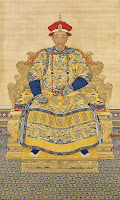Dragons are deeply rooted in the Chinese
culture. This mythological symbol dates back to 3000 BC and stands for
happiness, immortality, procreation, fertility and activity. The Chinese call
the dragon lóng - 竜 and it is the first of the four Divine
Creatures to Chinese – the others being the unicorn, the phoenix and the
tortoise. The Chinese often consider themselves, 'the descendants of the
dragon' (龍的傳人; pinyin: lóng de chuán rén).
Chinese dragon has the following nine
characteristics:
- head is like a camels,
- horns like a deer's,
- eyes like a hare's,
- ears like a bull's,
- neck like an iguana's,
- belly like a frog's,
- scales like those of a carp,
- paws like a tiger's, and
- claws like an eagle's.

It has nine times nine scales, it being the extreme of a lucky number. Dragons were believed to lay eggs, and the young dragon to remain in its egg for 3,000 years - 1,000 in the water, 1,000 in the mountains, and 1,000 in the land of men. Its benevolence signifies greatness, goodness and blessings. A dragon overcomes obstacles until success. Dragon is energetic, decisive, optimistic, intelligent and ambitious.
- Heavenly Dragon (天龍; pinyin: tián lóng) or celestial dragon was the celestial guardian who protected the heavens, supporting the mansions of the gods and shielded them from decay;
- Weather/Water Dragon (神龍; pinyin: shén lóng) were the weather makers and governed the wind, clouds and rain on which all agrarian life depended (the year 2012 was a year of the water dragon);
- Earth Dragon (地龍; pinyin: dì lóng) ruled the rivers, springs and lakes;
- Treasure Dragon (伏藏龍; pinyin: fú cáng lóng) lived in caves deep in the earth and had charge of all the precious jewels and metals buried in the earth.

Each of these dragons had a magical pearl that
was reputed to multiply if it was touched. This pearl was as symbol of the most
valuable treasure, wisdom.
The Chinese Dragon symbolizes power and
excellence, valiancy and boldness, heroism and perseverance, nobility and
divinity. It used to be the Imperial
emblem of Chinese emperors and the Imperial command. The Emperor alone
had nine of dragons on his brocade.
So, there was no coincidence in choosing a
dragon as a cover picture of my book representing leaders.

No comments:
Post a Comment
Note: Only a member of this blog may post a comment.